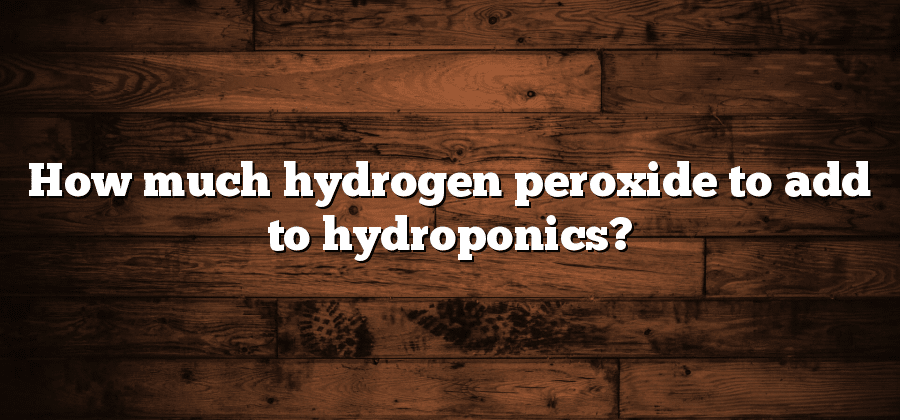Understanding the Role of Hydrogen Peroxide in Hydroponics
Hydrogen peroxide, a common household disinfectant, may seem like an unusual addition to a hydroponic system. However, it plays a vital role in ensuring the overall health and well-being of plants in this soilless cultivation method. Hydrogen peroxide is a powerful oxidizing agent, meaning it can break down harmful substances and create a more hospitable environment for plant roots.
One of its primary functions in hydroponics is to combat root diseases caused by harmful pathogens such as Pythium and Fusarium. These pathogens can thrive in the warm and moisture-rich environment of hydroponic systems, leading to root rot and stunted growth. Hydrogen peroxide acts as a defense mechanism against these pathogens by releasing oxygen molecules that effectively inhibit their growth. Additionally, it helps to oxygenate the root zone, improving nutrient uptake and stimulating healthy root development.
The Benefits of Adding Hydrogen Peroxide to Hydroponic Systems
Hydrogen peroxide is a valuable addition to hydroponic systems, offering numerous benefits for both plants and growers. One notable advantage is its ability to control and prevent the growth of harmful pathogens and diseases. Hydroponic systems provide an ideal environment for the proliferation of pathogens, making it crucial to maintain a clean and disease-free system. By incorporating hydrogen peroxide into the nutrient solution, growers can effectively ward off pathogens and reduce the risk of plant infections, ensuring healthier and more robust crops.
Moreover, hydrogen peroxide can also promote healthier root development in hydroponic plants. In a hydroponic system, the roots are exposed to nutrient solutions continuously, and any adverse conditions can impact their growth and vitality. Hydrogen peroxide helps combat root diseases, such as Pythium and Fusarium, which can hinder root function and nutrient absorption. Additionally, it enhances oxygen levels in the root zone, improving nutrient uptake and stimulating root growth. As a result, plants are better equipped to absorb essential nutrients, leading to enhanced overall growth and increased yields.
Factors to Consider When Determining Hydrogen Peroxide Dosage for Hydroponics
Factors to Consider When Determining Hydrogen Peroxide Dosage for Hydroponics
When it comes to determining the appropriate dosage of hydrogen peroxide for your hydroponic system, there are several factors that need to be taken into consideration. Firstly, the size of your hydroponic setup plays a crucial role in determining the dosage. Larger systems will generally require higher concentrations of hydrogen peroxide to effectively combat pathogens and maintain optimal plant health. On the other hand, smaller systems may require lower dosages to avoid any potential harm to the delicate root systems.
Another important factor to consider is the stage of plant growth. Different plants have varying levels of tolerance to hydrogen peroxide, especially in their early growth stages. Therefore, it is crucial to consider the specific needs of your plants and adjust the dosage accordingly. It is recommended to start with a lower dosage and gradually increase it as the plants establish themselves and become more resilient. This will help avoid any adverse effects on the plants and allow them to thrive in a controlled environment.
In conclusion, determining the right dosage of hydrogen peroxide for your hydroponic system requires careful consideration of the size of your setup and the specific needs of your plants at different stages of growth. By finding the perfect balance, you can effectively harness the benefits of hydrogen peroxide without compromising the health and vitality of your plants.
The Impact of Hydrogen Peroxide Concentration on Plant Health in Hydroponics
Hydrogen peroxide is a commonly used additive in hydroponic systems, known for its ability to improve plant health and overall growth. However, it is important to note that the concentration of hydrogen peroxide used can have a significant impact on the health of the plants. High concentrations of hydrogen peroxide can be detrimental to plant growth, causing root damage and even plant death.
When determining the appropriate concentration of hydrogen peroxide for hydroponics, it is crucial to consider several factors. These include the type of plants being grown, the stage of growth, and the overall health of the plants. It is recommended to start with a lower concentration and gradually increase it until the desired effects are achieved. Monitoring the plants closely for any signs of stress or damage is essential in ensuring that the hydrogen peroxide concentration is at the optimal level for plant health in hydroponics.
How to Calculate the Correct Amount of Hydrogen Peroxide for Hydroponic Solutions
Hydrogen peroxide is a valuable tool in hydroponics, offering benefits such as improving oxygen levels in the nutrient solution and promoting healthy root development. However, determining the correct amount of hydrogen peroxide to use can be a bit tricky. To ensure optimal results and avoid any negative effects on plants, it is important to calculate the correct dosage accurately.
The first step in calculating the amount of hydrogen peroxide needed is to consider the volume of the nutrient solution. This can be measured in liters or gallons, depending on your preference. Once you have the volume, you can determine the dosage using a standard concentration of hydrogen peroxide. It is recommended to use a 3% hydrogen peroxide solution, as higher concentrations may be too strong for plants and can cause damage. By referring to a conversion table, you can easily calculate the amount of hydrogen peroxide required for your specific volume of nutrient solution. Remember to wear appropriate protective gear, such as gloves and goggles, when handling hydrogen peroxide as a safety precaution.






